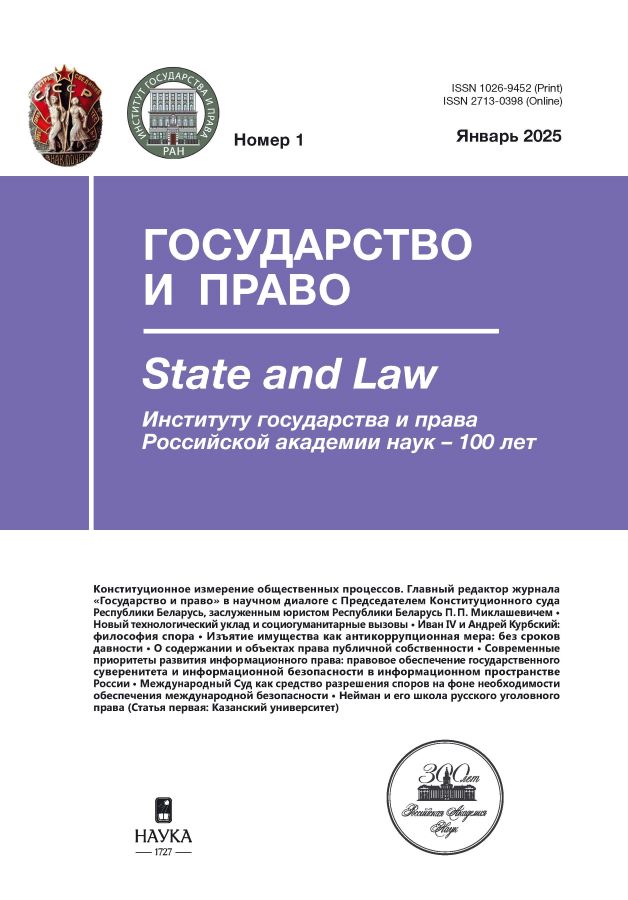Establishment of protective zones of specially protected natural territories
- 作者: Luneva E.V.1,2
-
隶属关系:
- Kazan (Volga Region) Federal University
- St. Petersburg State University
- 期: 编号 1 (2025)
- 页面: 135-144
- 栏目: Environmental law
- URL: https://ter-arkhiv.ru/1026-9452/article/view/678458
- DOI: https://doi.org/10.31857/S1026945225010126
- ID: 678458
如何引用文章
详细
The paper examines the shortcomings of legal techniques (legal uncertainty, legal gaps, lack of specification of legal norms) in the establishment of protection zones for especially protected natural territories (hereinafter – SPNT). The definition of protection zones for SPNT is formulated, and their role in preserving the latter is demonstrated. The need for mandatory creation of protection zones for all categories of federal, regional, and local SPNTs is justified, not only around state nature reserves, national parks, natural parks, and nature monuments. The absence or delayed establishment of protection zones for many regional nature parks and nature monuments of regional importance is identified. Features of imperativeness in their establishment emerged at the end of 2013, as well as the reasons for the current situation (uncertainty about the deadline for establishment, lack of specification of legal norms regarding the moment when the obligation to develop a decision on establishing a protection zone for regional SPNT arises, special procedures for establishing protection zones for border SPNTs of regional and local importance, as well as the possibility of establishing a single protection zone for closely located SPNTs). Taking into account the judicial practice, recommendations for amending the legislation on the establishment of protection zones for SPNT are formulated.
全文:
作者简介
Elena Luneva
Kazan (Volga Region) Federal University; St. Petersburg State University
编辑信件的主要联系方式.
Email: vilisa_vilisa@mail.ru
ORCID iD: 0000-0001-6666-5353
Doctor of Law, Associate Professor, Professor of the Department of Environmental, Labor Law and Civil Procedure, Kazan (Volga Region) Federal University; Associate Professor of the Department of Environmental Law, St. Petersburg State University
俄罗斯联邦, 18 Kremlevskaya str., 420008 Kazan; 7–9 Universitetskaya Embankment, 199034 St. Petersburg参考
- Brinchuk M. M., Dubovik O. L., Zozulya V. V. et al. Commentary to the Federal Law of March 14, 1995 No. 33-FZ “On Specially Protected Natural Territories” (article-by-article) / ed. by O. L. Dubovik. 2nd ed., rev. and add. // SPS “ConsultantPlus”. 2015 (the author of the commentary to art. 2 (paragraph 3.4) is V. V. Zozulya) (in Russ.).
- Zhilyaeva E. A. Modern problems of legal regulation of the regime of specially protected natural territories // Fundamental research. 2006. No. 2. P. 77 (in Russ.).
- Zolotova O. A. The legal regime of the lands of protected zones: abstract … PhD in Law. M., 2013. P. 20 (in Russ.).
- Zolotova O. A. The legal regime of the lands of protected zones: dis. … PhD in Law. M., 2013. Pp. 98, 99 (in Russ.).
- Zolotova O. A. The legal regime of lands of protected areas of natural objects and complexes // Journal of Russ. law. 2013. No. 5. P. 73 (in Russ.).
- Kozyr O. M. Specially protected natural territories – an analysis of modern legal regulation // Agrarian and Land Law. 2009. No. 11 (59). P. 68 (in Russ.).
- Luneva E. V. Legal protection of geo-diversity // Journal of Russ. law. 2024. Vol. 28. No. 3. P. 96. doi: 10.61205/jrp.2024.3.4 (in Russ.).
- Luneva E. V. The legal regime of land plots in specially protected natural territories. M., 2018. Pp. 28, 29 (in Russ.).
- Petrov V. V. Ecology and law. M., 1981. P. 106 (in Russ.).
- Shirokov K. M. Features of the legal regime of land plots in the boundaries of protected areas of specially protected natural territories // Justice. 2020. Vol. 2. No. 2. Pp. 195, 198–201 (in Russ.).
- He Z. H.U., Jia-ming L.I.U. Spatial evolution of the peripheral area of nature reserve under the guidance of tourism: Taking the peripheral area of Changbai Mountain National Nature Reserve as an example // Journal of Natural Resources. 2023. No. 38 (4). Pp. 919, 920. doi: 10.31497/zrzyxb.20230406
- Mathevet R., Thompson J. D., Folke C., Chapin F. S. III. Protected areas and their surrounding territory: socioecological systems in the context of ecological solidarity // Ecological Applications. 2016. No. 26 (1). P. 14. doi: 10.1890/14-0421
补充文件









